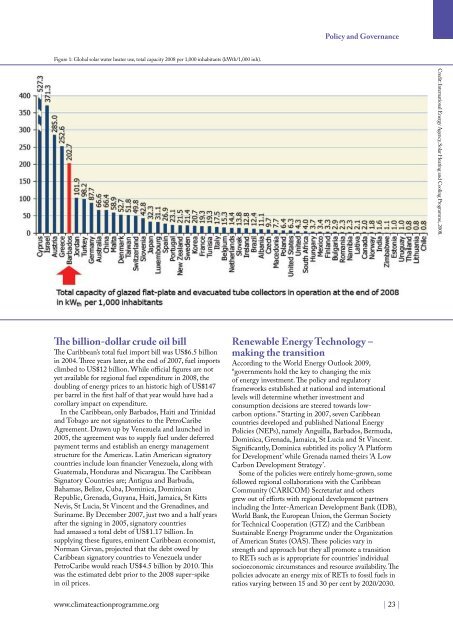Climate Action 2010-2011
Create successful ePaper yourself
Turn your PDF publications into a flip-book with our unique Google optimized e-Paper software.
Policy and Governance<br />
Figure 1: Global solar water heater use, total capacity 2008 per 1,000 inhabitants (kWth/1,000 inh).<br />
Credit: International Energy Agency, Solar Heating and Cooling Programme, 2008.<br />
The billion-dollar crude oil bill<br />
The Caribbean’s total fuel import bill was US$6.5 billion<br />
in 2004. Three years later, at the end of 2007, fuel imports<br />
climbed to US$12 billion. While official figures are not<br />
yet available for regional fuel expenditure in 2008, the<br />
doubling of energy prices to an historic high of US$147<br />
per barrel in the first half of that year would have had a<br />
corollary impact on expenditure.<br />
In the Caribbean, only Barbados, Haiti and Trinidad<br />
and Tobago are not signatories to the PetroCaribe<br />
Agreement. Drawn up by Venezuela and launched in<br />
2005, the agreement was to supply fuel under deferred<br />
payment terms and establish an energy management<br />
structure for the Americas. Latin American signatory<br />
countries include loan financier Venezuela, along with<br />
Guatemala, Honduras and Nicaragua. The Caribbean<br />
Signatory Countries are; Antigua and Barbuda,<br />
Bahamas, Belize, Cuba, Dominica, Dominican<br />
Republic, Grenada, Guyana, Haiti, Jamaica, St Kitts<br />
Nevis, St Lucia, St Vincent and the Grenadines, and<br />
Suriname. By December 2007, just two and a half years<br />
after the signing in 2005, signatory countries<br />
had amassed a total debt of US$1.17 billion. In<br />
supplying these figures, eminent Caribbean economist,<br />
Norman Girvan, projected that the debt owed by<br />
Caribbean signatory countries to Venezuela under<br />
PetroCaribe would reach US$4.5 billion by <strong>2010</strong>. This<br />
was the estimated debt prior to the 2008 super-spike<br />
in oil prices.<br />
Renewable Energy Technology –<br />
making the transition<br />
According to the World Energy Outlook 2009,<br />
“governments hold the key to changing the mix<br />
of energy investment. The policy and regulatory<br />
frameworks established at national and international<br />
levels will determine whether investment and<br />
consumption decisions are steered towards lowcarbon<br />
options.” Starting in 2007, seven Caribbean<br />
countries developed and published National Energy<br />
Policies (NEPs), namely Anguilla, Barbados, Bermuda,<br />
Dominica, Grenada, Jamaica, St Lucia and St Vincent.<br />
Significantly, Dominica subtitled its policy ‘A Platform<br />
for Development’ while Grenada named theirs ‘A Low<br />
Carbon Development Strategy’.<br />
Some of the policies were entirely home-grown, some<br />
followed regional collaborations with the Caribbean<br />
Community (CARICOM) Secretariat and others<br />
grew out of efforts with regional development partners<br />
including the Inter-American Development Bank (IDB),<br />
World Bank, the European Union, the German Society<br />
for Technical Cooperation (GTZ) and the Caribbean<br />
Sustainable Energy Programme under the Organization<br />
of American States (OAS). These policies vary in<br />
strength and approach but they all promote a transition<br />
to RETs such as is appropriate for countries’ individual<br />
socioeconomic circumstances and resource availability. The<br />
policies advocate an energy mix of RETs to fossil fuels in<br />
ratios varying between 15 and 30 per cent by 2020/2030.<br />
www.climateactionprogramme.org | 23 |












